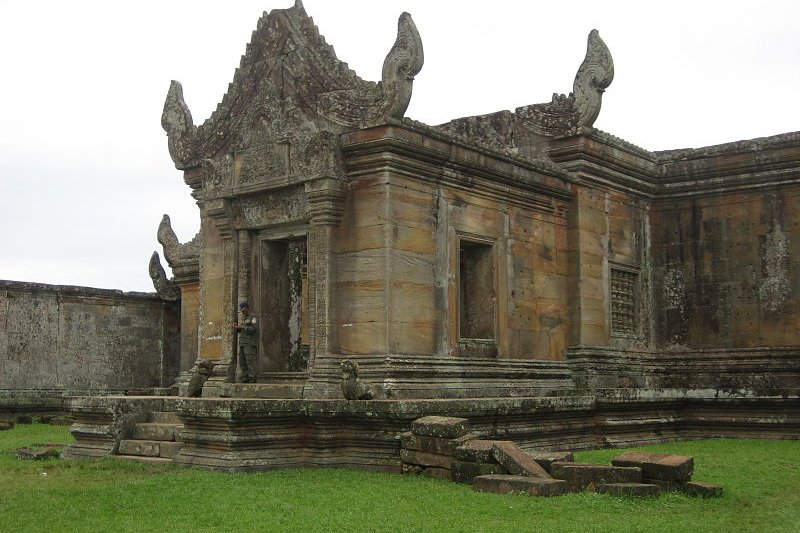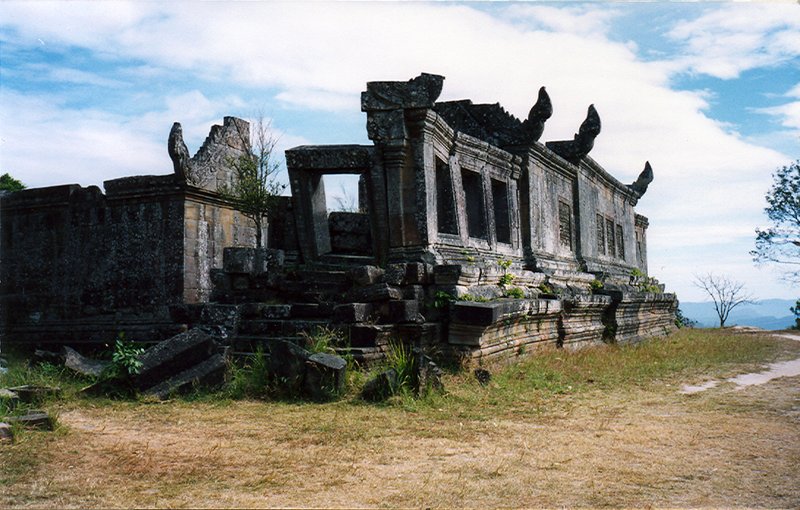 Preah Vihear, Cambodia
Preah Vihear, CambodiaSource: https://commons.wikimedia.org/wiki/File:Preah-vihear.jpg
Author: William Brehm

Author: William Brehm

The Temple of Preah Vihear, or Prasat Preah Vihear, is an ancient Khmer temple in Cambodia. It is dedicated to the Hindu god Shiva. The temple was inscribed as a World Heritage Site during the 32th session of the World Heritage Committee which met in Quebec City, Canada on 2-10 July, 2008.
The Temple of Preah Vihear is celebrated for its unique architectural layout. It is located on a 525-meter high (1,720 feet) cliff in Preah Vihear province, near the border with Kantharalak district, in Sisaket Province of Thailand. The temple has been a site of a bitter and long-standing dispute between Cambodia and Thailand. This was brought to the International Court of Justice in The Hague in 1962, which ruled in favour of Cambodia.
Prasat Preah Vihear comprises a series of sanctuaries linked by a network of pavements and staircases on a 800-meter axis. It is regarded as an outstanding masterpiece of Khmer architecture, pure in plan and in the detail of its decoration.
 The ruins of Preah Vihear
The ruins of Preah VihearSource: https://commons.wikimedia.org/wiki/File:Khao_phra_viharn_001.png
Author: Detlef Garbrecht

Author: Detlef Garbrecht

World Heritage Site Inscription Details
Location: N 14 23 18 E 104 41 2Inscription Year: 2008
Type of Site: Cultural
Inscription Criteria: I
About Preah Vihear
Due to its located high up on a cliff, the temple of Preah Vihear has one of the most spectacular view of all the ancient Khmer monuments. Unlike most ancient Khmer temples, which are built to face the east, Preah Vihear was laid out on a north-south axis.The temple of Preah Vihear is written as Prasat Phra Viharn or Prasat Khao Phra Viharn in Thai. Prasat is a word meaning "temple" or "edifice" in both Khmer and Thai. The word "Preah" in Khmer, or "Phra" in Thai, means sacred. Vihear, or Viharn and some times Wihan in Thai, means "shrine" or "abode", and comes from the Sanskrit word "vihara". Thus the name Preah Vihear can be translated as "Sacred Abode".
The site where Preah Vihear is standing has been used for a temple going back to the early 9th century. From the earliest beginning, the temple there was dedicated to the Hindu deity Shiva. However, the earliest part of Preah Vihear dates from the 10th century, which coincides with the Koh Ker period. There are elements of the Banteay Srei style of architecture at Preah Vihear, dating it to the late 10th century.
Much of the temple was actually built during the reigns of Suryavarman I (1002-1050) and Suryavarman II (1113-1150), the main builder of Angkor Wat.
Preah Vihear is located on a cliff in the Dangrek Mountains which marks the border between Thailand and Cambodia. As a result, it has been part of either Cambodia or Thailand. The dispute can be traced as early at 1904, when the Siamese and French colonial authorities then ruling Cambodia demarcate the border of Siam and Cambodia. The border followed the watershed line of the Dangrek mountain range, which places almost the whole temple complex within Thailand. However, the resulting map drawn by French officers in 1907 deviated from the watershed, placing the temple on Cambodia's side of the border.
In 1957, following the withdrawal of the French from Cambodia, Thailand sent troops to occupy the temple, drawing protest from Cambodia, and in 1959 calling on the International Court of Justice to rule that the temple and its surrounding lay are indeed within Cambodian territory. Because of Preah Vihear - and that controversial map of 1907 - relations between Thailand and Cambodia soured. The International Court of Justice on 15 June, 1962 ruled that the temple belonged to Cambodia. It pointed that out for five decades the Siamese/Thai authorities did not object in any international forums of the map's depiction of the location of Preah Vihear. Also, they did not object when in 1930, a French colonial official received Prince Damrong, a Siamese scholar and government figure, at the temple. Moreover, Thailand had benefited in other ways from the border treaty. Therefore, through such acts, Thailand had demonstrated its acceptance of the 1907 map, and that Preah Vihear belongs to Cambodia.
Thailand reacted angrily to the ruling, pointing fingers to the jury which they regard as bias. There was mass protests in the country. In demonstration of their displeasure at having to give up Preah Vihear, the Thai soldiers dug up and removed the flag pole bearing the Thai flag as it is still flying, rather than lowering it at the site. Cambodia formally took over Preah Vihear in January, 1963, in a ceremony attended by some 1,000 people who had to make the arduous climb from the Cambodian side. The then young and fit Prince Sihanouk negotiated the climb in less than an hour. At the ceremony, he made a gesture of conciliation to Thailand, allowing Thais to visit the temple without visa, and allowing Thailand to keep any antiquities it may have taken from the site.
The declaration by the World Heritage Committee in inscribing Preah Vihear as a World Heritage Site in 2008 was met with protests once again from Thailand, which argued that it should be a joint effort.The two countries eventually reached an agreement that Cambodia should propose the site for inscription, with the active support of Thailand. However, the opposition parties in Thailand attacked Thailand's support. Caving in to political pressure, Thailand withdrew its formal support for the listing of Preah Vihear. Cambodia proceeded with the application, despite protests from Thai officials, and on 7 July, 2008, the Temple of Preah Vihear was inscribed as a World Heritage Site.
Visiting Temple of Preah Vihear
Your base for visiting this World Heritage Site is XXX. From there, you can make the arrangement, either on your own or through a travel agency, to go to Temple of Preah Vihear.Getting there
The Temple of Preah Vihear can be reached from Tbeng Meanchey in Cambodia, or from Siem Reap. It can also be approached from Kantharalak district of the Sisaket Province in Thailand. Entrance fee is US$5 or 200 baht for foreigners entering from Cambodia, except for Thai nationals that only pay 50 baht. From the Thai side, Thailand imposes an entrance fee of 400 baht for entering the Khao Phra Wihan National Park which is on the Thai side of the border. Latest updates on Penang Travel Tips
Latest updates on Penang Travel Tips
 Map of Roads in Penang
Map of Roads in Penang
Looking for information on Penang? Use this Map of Roads in Penang to zoom in on information about Penang, brought to you road by road.
Copyright © 2003-2025 Timothy Tye. All Rights Reserved.

 Go Back
Go Back